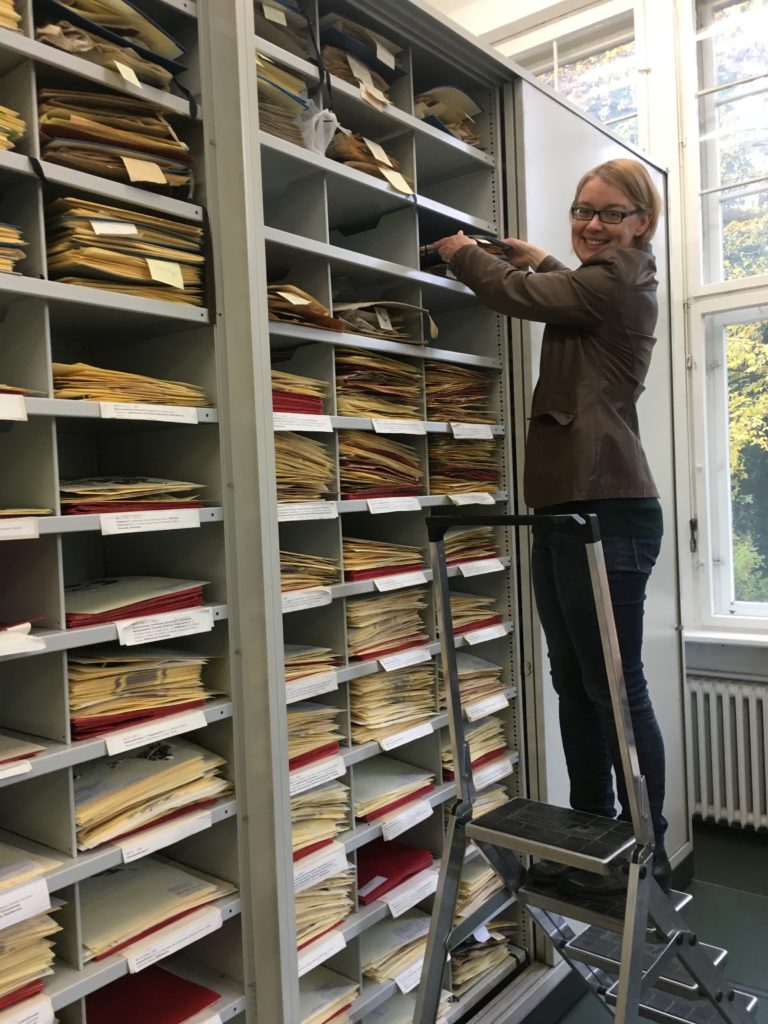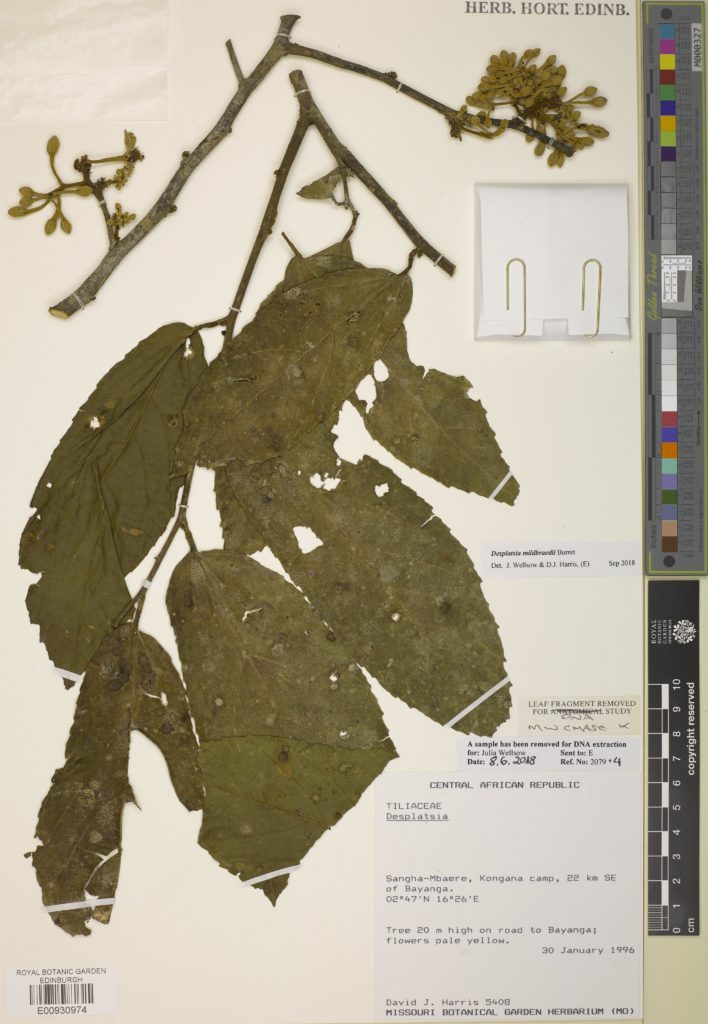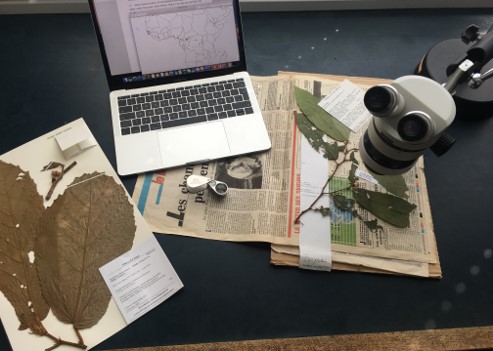Desplatsia is a genus of small trees growing in the forests of West and Central Africa. Their fruits are rather large and adored by elephants. There was some confusion on the number of species present in this genus, so a taxonomic revision was called for.
I had chosen to revise Desplatsia for my Masters project within the MSc course of Biodiversity & Taxonomy of Plants. “Revise” in a taxonomic context means to decide how many species there are in a genus by looking at as many herbarium specimens as possible in as many relevant herbaria as possible, describing these species, producing a ‘key’ and publishing the revision as a peer-reviewed paper. With the support of my supervisors David, Peter and Michelle I learned how to do all those things, and in addition to that, I learned what else is needed to survive the ups and downs of herbarium life.

Me at Munich herbarium climbing a ladder when searching for a specimen in the cabinets.
Staring at specimens does help! On the first day of my Masters project David gave me a pile of specimens of dried plants in old newspapers – his Desplatsia collections from the Central African Republic and Cameroon made in the late eighties and early nineties. I neatly put them away in boxes and for a couple of weeks did not dare to look at them, because I was not too sure what to look at exactly. Instead, I preferred to spend my days either in the library, reading through African floras and old 19th century protologues (= first description of a species), in the hope to find clues telling me what to look at exactly (stipules apparently!), or in the lab, isolating DNA from small samples of the specimens I had taken before filing them away. When I finally could not avoid any longer looking at the specimens and had gathered the needed courage to actually do so – they all seemed to look the same, dried brown or green leaves! Oh dear!
Later on I went to Kew with David, to look at Kew’s impressively large collection of Desplatsia specimens. This was an immensely helpful thing to do – because once we had looked at them over a whole week (July 2018 – 40°C in Central London!), they seemed to develop certain features that I had not noticed before, and – hey presto! – telling the species apart all of a sudden seemed obvious. Even at Paris (where I went to later by myself to look at further Desplatsia specimens) and even online (the only option we had for looking at Naturalis’ specimens due to the closure of the Leiden herbarium for renovation – luckily all digitized and all online for Desplatsia). So in the end I was, much to my amazement, able to find enough features and characters to write a key and species descriptions for the four Desplatsia species we had decided to recognize.
I finally mounted David’s Desplatsia specimens with Kate’s help, and digitized them with Robyn’s help, so they all look lovely now and are online on RBGE’s herbarium catalogue


Things needed to mount herbarium specimens: cardboard sheets, acid free glue, needle and thread, adhesive tape, paint brush, paper capsule, sponge, a pair of scissors, tweezers, heavy sand bags
Curating databases: Before working in a herbarium, I did have a vague idea of what “curating” a herbarium collection might involve, but had literally no idea that you could also “curate” databases. My somewhat romantic vision of herbarium work did not involve computers – and it turns out I could not have been more wrong! In fact, I ended up spending an ample amount of time databasing our 800 Desplatsia specimens we looked at, adding metadata (such as collector, collection date, geo data etc.) and cleaning the data (who would have thought you could legitimately “clean” data as long as you correctly cite the method you use?). All this, of course, also involved constant visits to RBGE’s canteen for more coffee, and several panic attacks due to computer break-downs and near-losses of data that could only just be avoided thanks to David coming to my rescue. But all this paid off when generating lovely distribution maps of our four Desplatsia species, Red List assessment using GeoCAT with Peter’s and Sanna’s help, as well as impressive specimen citation lists by just one or two single mouse clicks using BRAHMS.

Because it looks like it! Obviously, I had heard this one sentence plenty of times before when asking plant expert how they recognized a certain plant: “Because it looks like it!” In the past I had always considered this as not very helpful for a student trying to learn about key characters of plants.
But after having looked at 800 Desplatsia specimens it somehow seemed to make sense – it is not a Desplatsia mildbraedii because there are these particular hairs, teeth, flowers (never there when you need them anyway!), or fruits (well hidden in the carpological collection in the basement of most herbaria for some reason!) – but just because it looks like it! I also love using this phrase now – even though I am fully aware I can only use it with confidence for exactly four plant species, our four Desplatsia species.
Our taxonomic revision treats four species covering 15 countries in Africa, 12 species names including three new synonyms, and about 800 specimens. It is published in the European Journal of Taxonomy (Wellsow et al. 2019), and in addition we uploaded our specimen data to the data repository Dryad (Harris & Wellsow 2019) and the GFBio portal (Wellsow & Harris 2019).
References:
Wellsow J., Hart M., Wilkie P. Harris, D.J. (2019) A taxonomic revision of the African genus Desplatsia Bocq. (Malvaceae – Grewioideae). European Journal of Taxonomy 584: 1-38. https://doi.org/10.5852/ejt.2019.584
Harris D.J. & Wellsow J. (2019). A taxonomic revision of the African genus Desplatsia Bocq. (Malvaceae – Grewioideae) with identifiers, v4, Dryad, Dataset. https://doi.org/10.5061/dryad.j6q573n89
Wellsow J. & Harris D.J. (2019). A taxonomic revision of the African genus Desplatsia Bocq. (Malvaceae – Grewioideae). Dataset: Version: 20191127. Data Publisher: Staatliche Naturwissenschaftliche Sammlungen Bayerns – SNSB IT Center, München. https://doi.org/10.25897/5/2war-9p81.
